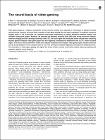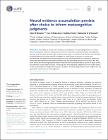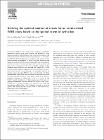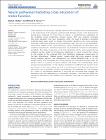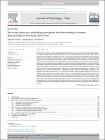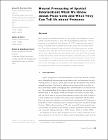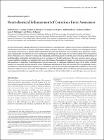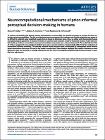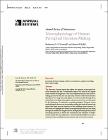Browsing Psychology (Scholarly Publications) by Title
Now showing items 274-293 of 447
-
A national evaluation of the Irish public health counselling in primary care service examination of initial effectiveness data.
(2021)Background The Counselling in Primary Care service (CIPC) is the first and only nationally available public counselling service in the Republic of Ireland. This study provides initial data for the effectiveness of ... -
The neural basis of video gaming
(2011)Video game playing is a frequent recreational activity. Previous studies have reported an involvement of dopamine-related ventral striatum. However, structural brain correlates of video game playing have not been investigated. ... -
The neural correlates of deficient error awareness in attention-deficit hyperactivity disorder (ADHD)
(2009)The ability to detect and correct errors is critical to adaptive control of behaviour and represents a discrete neuropsychological function. A number of studies have highlighted that attention-deficit/hyperactivity ... -
Neural evidence accumulation persists after choice to inform metacognitive judgments.
(2015)The ability to revise one's certainty or confidence in a preceding choice is a critical feature of adaptive decision-making but the neural mechanisms underpinning this metacognitive process have yet to be characterized. ... -
Neural mechanisms for response selection: comparing selection of items and responses from working memory.
(Elsevier, 2007)Recent functional imaging studies of working memory (WM) have suggested a relationship between the requirement for response selection and activity in dorsolateral prefrontal (DLPFC) and parietal regions. Although a number ... -
Neural mechanisms involved in error processing: A comparison of errors made with and without awareness
(Elsevier, 2005)The ability to detect an error in one's own performance and then to improve ongoing performance based on this error processing is critical for effective behaviour. In our event-related fMRI experiment, we show that explicit ... -
Neural pathways mediating cross education of motor function.
(2013)Cross education is the process whereby training of one limb gives rise to enhancements in the performance of the opposite, untrained limb. Despite interest in this phenomenon having been sustained for more than a century, ... -
Neural processing of Spatial Information: What we know about Place cells and what they can tell us about Presence.
(MIT Press, 2006)Brain processing of spatial information is a very prolific area of research in neuroscience. Since the discovery of place cells (PCs)(O'Keefe & Dostrovsky, "The hippocampus as a spatial map," Brain Research 34, 1971) ... -
Neurochemical enhancement of conscious error awareness.
(2012)How the brain monitors ongoing behavior for performance errors is a central question of cognitive neuroscience. Diminished awareness of performance errors limits the extent to which humans engage in corrective behavior and ... -
Neurocomputational mechanisms of prior-informed perceptual decision-making in humans
(2021)To interact successfully with diverse sensory environments, we must adapt our decision processes to account for time constraints and prior probabilities. The full set of decision-process parameters that undergo such flexible ... -
Neuromorphic vibrotactile stimulation of fingertips for encoding object stiffness in telepresence sensory substitution and augmentation applications
(2018)We present a tactile telepresence system for real-time transmission of information about object stiffness to the human fingertips. Experimental tests were performed across two laboratories (Italy and Ireland). In the ... -
Neurophysiology of Human Perceptual Decision-Making
(2021)The discovery of neural signals that reflect the dynamics of perceptual decision formation has had a considerable impact. Not only do such signals enable detailed investigations of the neural implementation of the ... -
Non-use of Formal Health Services in Malawi: Perceptions from Non-users.
(2014)BACKGROUND: The study upon which this paper is based was undertaken to understand users' and non-users' perceptions concerning facilitators and barriers to equitable and universal access to health care in resource-poor ... -
A noradrenergic theory of cognitive reserve: Implications for Alzheimer s disease
(2013)The gap between symptoms and pathology in Alzheimer's disease has been explained by the hypothetical construct of ?cognitive reserve??a set of variables including education, intelligence, and mental stimulation which ...






